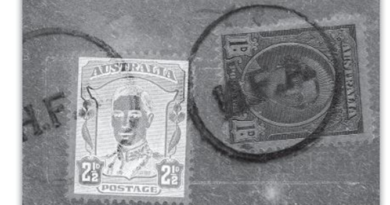From the obscure to the inaccessible
The society was treated to a brief Zoom talk by Paul Walton entitled “From the obscure to the inaccessible”, who started his presentation by firstly covering the “obscure” aspect with details of the single stamp issue of King Edward VII Land.

This stamp was used by the Shackleton Antarctic Expedition of 1908. The New Zealand 1d Penny Universal stamp was overprinted ‘King Edward VII Land’.
Shackleton had intended making his base camp in King Edward VII Land in the Antarctic but after failing to find a suitable landing place he made his base at McMurdo Sound, which was in fact in Victoria Land.
The Expedition left England in the Nimrod on 7 August 1907. Its last port of call en route to Antarctica was Lyttleton, New Zealand, where final departure for the southern continent was made on 1 January 1908.
Shackleton was appointed to be a Postmaster by the New Zealand Government and was provided with a special date stamp – the date stamp read “Brit. Antarctic Expedition” in a circle with ‘NZ’, time and date in four lines in the centre.

Paul then moved on to talk about Victoria Land.
Two stamps were used by the Scott Antarctic Expedition of 1910-1913.

The Expedition left England in the ship Terra Nova on 15 June 1910 and departed Port Chalmers, New Zealand on 29 November 1910 arriving in Mc Murdo Sound, Antarctica on 4 January 1911.
Captain Scott was appointed Postmaster by the New Zealand Government for the duration of the Expedition.
The New Zealand stamps, a 1/2d Edward VII and 1d Dominion were overprinted ‘Victoria Land’. The Expedition also used the same date stamp as was used on the 1908 Shackleton Antarctic Exhibition.
Scott’s team achieved their objective of reaching the South Pole, only to find they had been beaten by the Norwegian Expedition led by Amundsen. The group of five men (including Scott) all perished on the march back to the coast.
The halfpenny Edward VII and penny Dominion stamps were overprinted ‘Victoria Land’ in connection with Scott’s ill-fated Antarctic expedition. Only ten sheets were overprinted and fewer than two thousand copies of the stamp were issued to the public; these stamps are rare indeed.
————————-
The second part of Paul’s talk covered the “Inaccessible” aspect and focused on the “scramble for Africa” and in particular the Belgian Congo. The Belgian Congo was a Belgian colony in Central Africa from 1908 until its independence in 1960. It adopted its present name, the Democratic Republic of the Congo (DRC) in 1964.
Paul touched on the racial discrimination and terrible social inequality prevalent at that time. The black populations were subject to curfews and excluded from certain city areas and Paul drew parallels to the current Black Lives Matter protests, which are currently raising and highlighting discrimination and inequality issues, albeit 70 years on.
Paul showed a range of sets of stamps issued by the Belgian Congo in 1894, 1923 and 1942 respectively, which displayed fascinating scenes, animals and people.


